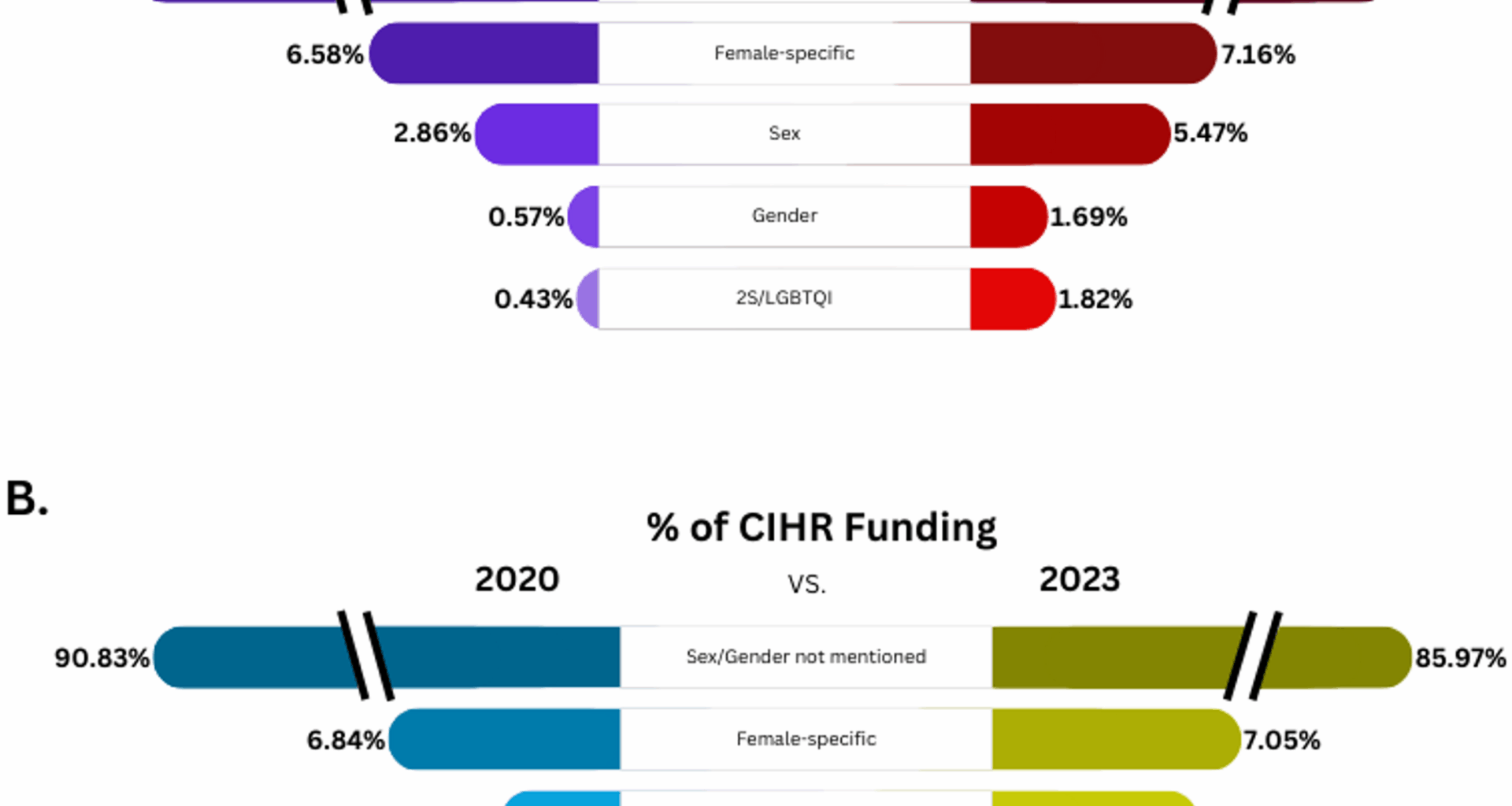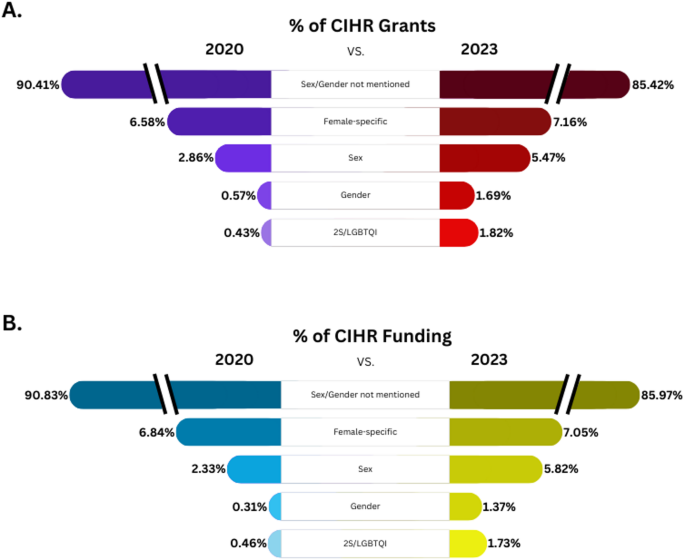In total, there were 775 project grants that received CIHR funding in 2023. Seven bridge grants were removed, leaving a total of 768 unique project grants that received a total of $651,948,708 in research funding. In 2023, the average project grant received $848,892 in research funding.
The percentage of funded grant abstracts mentioning sex or gender doubled in 2023 from 2020 at 5.5% and 1.7% respectively, whereas grant abstracts mentioning 2S/LGBTQI quadrupled during that same time period to 1.8% of the total grant abstracts funded
Compared to 2020, significant improvements were noted in nearly each category of our analysis, with the exception of female health. The percentage of funded grant abstracts that mentioned sex significantly increased, nearly doubling from 2.86% (20 out of 699) in 2020 to 5.47% (42 out of 768) in 2023 (z = 2.48, p = 0.013, 95% CI: [0.58%, 4.64%]). Similarly, the percentage of grant abstracts that mentioned gender significantly increased, nearly tripling from 0.57% (4 out of 699) in 2020 to 1.69% (13 out of 768) in 2023 (z = 2.00, p = 0.045, 95% CI: [0.05%, 2.19%]). Moreover, the percentage of grant abstracts that included 2S/LGBTQI significantly increased, quadrupling from 0.43% (3 out of 699) in 2020 to 1.82% (14 out of 768) in 2023 (z = 2.49, p = 0.013, 95% CI: [0.33%, 2.46%]). Consistent with this, the percentage of grant abstracts that did not mention sex/gender of the populations to be studied significantly decreased from 90.41% (632 out of 699) in 2020 to 85.42% (656 out of 768) in 2023 (z = −2.92, p = 0.003, 95% CI: [−8.31%, −1.68%]) (Fig. 1A).
The percentage of funded grant abstracts mentioning female-specific populations did not significantly change from 2020 to 2023 at 7% of all grant funding
Unlike the increases seen in grant abstracts mentioning sex, gender, or 2S/LGBTQI populations, the percentage of grant abstracts that were female-specific did not significantly increase from 2020 to 2023 (z = 0.44, p = 0.66, 95% CI: [−2.01%, 3.17%]). Female-specific grant abstracts accounted for 7.16% (55 out of 768) of funded research project grants in 2023, which was a 0.58% increase from 6.58% (46 out of 699) of funded research project grants in 2020.
Funding totals for grant abstracts mentioning sex or gender doubled in 2023 from 2020, whereas grant abstracts mentioning 2S/LGBTQI quadrupled during that same time period
Increases in funding from 2020 to 2023 amounts largely paralleled findings of representation. The percentage of funding allocated to grants that mentioned sex of the population significantly increased, more than doubling from 2.33% ($12,299,505 out of $527,933,841) in 2020 to 5.82% ($37,935,788 out of $651,948,708) in 2023 (3.49% increase; z = 2951.56, p < 0.001, 95% CI: [3.47%, 3.49%]). The percentage of funding allocated to grants that mentioned gender significantly increased, quadrupling from 0.31% ($1,625,625 out of $527,933,841) in 2020 to 1.37% ($8,934,047 out of $651,948,708) in 2023 (1.06% increase; z = 1926.76, p < 0.001, 95% CI: [1.061%, 1.063%]). The percentage of funding allocated to grants that included 2S/LGBTQI populations significantly increased, nearly quadrupling from 0.46% ($2,444,176 out of $527,933,841) in 2020 to 1.73%($11,289,232 out of $651,948,708) in 2023 (1.27% increase; z = 2020.18, p < 0.001, 95% CI: [1.267%, 1.270%]). Consistent with this, the amount of funding allocated to grant abstracts that did not mention sex/gender significantly decreased from 90.83% ($479,499,892 out of $527,933,841) in 2020 to 85.97% ($560,499,430 out of $651,948,708) in 2023 (4.8% decrease; z = −2563.96, p < 0.001, 95% CI: [−4.86%, −4.85%]) (Fig. 1B).
Although small in magnitude, the percentage of funding allocated to grants that were female-specific significantly increased from 6.84% ($36,122,968 out of $527,933,841) in 2020 to 7.05% ($45,965,807 out of $651,948,708) in 2023 (0.21% increase; z = 139.76, p < 0.001, 95% CI: [0.205%, 0.211%]). When female-specific grant abstracts investigating cancer were removed, the percentage of funding allocated to grants that were female-specific significantly increased from 4.00% ($21,096,068 out of $527,933,841) in 2020 to 4.88% ($31,817,127 out of $651,948,708) in 2023 (0.88% increase; z = 729.79, p < 0.001, 95% CI: [0.882%, 0.887%]).
An infographic depicting the change in percentage of grants and funding between 2020 and 2023 for awarded Canadian institutes of Health Research (CIHR) grants for the different categories. The change in percentage (%) of grants (A) and funding amount (B) in the years 2020 and 2023 that did not mention of sex and gender in their grant abstracts or mentioned female-specific health, female-specific health not including cancer based grants, sex, gender, or 2S/LGBTQI health
Twice as many grants that studied 2S/LGBTQI persons were focused on male-specific research questions compared to female-specific questions
Only 1.82% of funded project grants (14 of 768) focused on 2S/LGBTQI persons. Of these, 28.57% focused on sexually/gender-diverse (e.g. gay, queer, bisexual, trans) men and 14.29% focused on sexually/gender-diverse (e.g. lesbian, queer, bisexual, trans) women. Although 2S/LGBTQI research focusing on sexually/gender-diverse men was double that of sexually-/gender-diverse women, the proportion difference was not statistically significant (OR = 2.33, p-value = 0.65, 95% CI: [0.27 to 30.87]).


